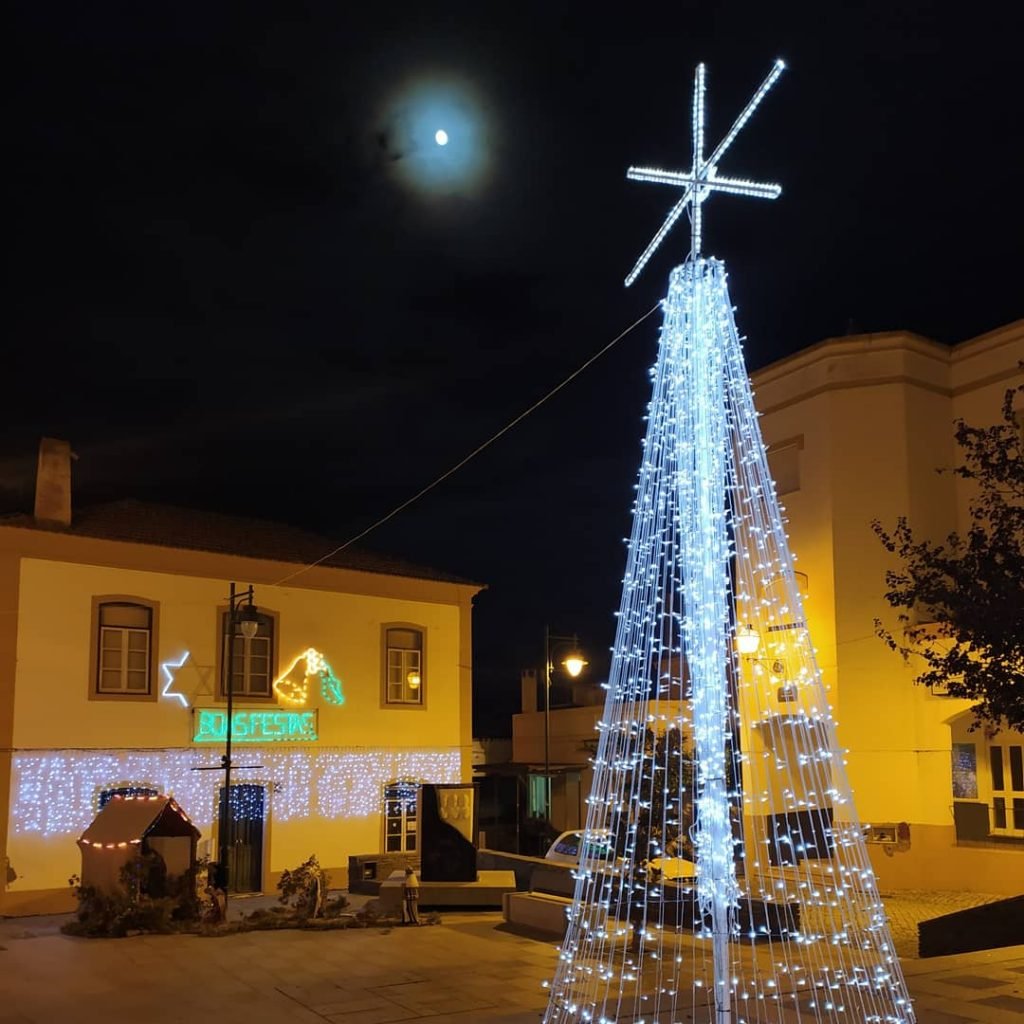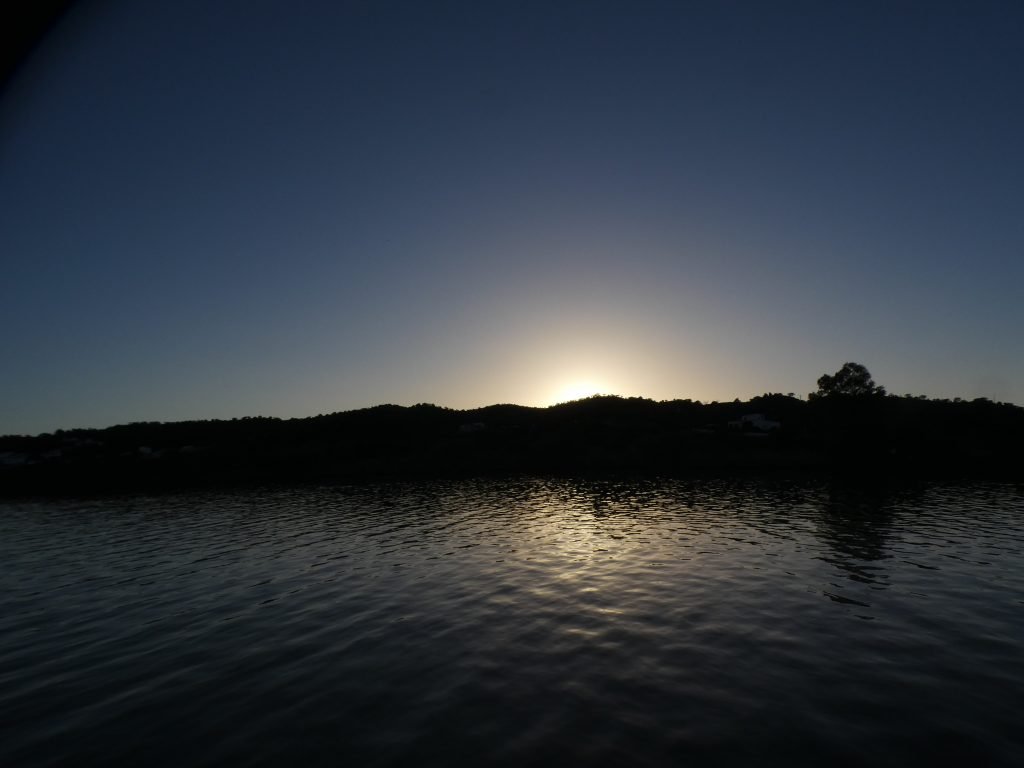We haven’t spoken much of Brexit in our blogs, mainly because I try to steer clear of politics. However, as background, we voted to remain and since that fateful day in June 2016, nothing has happened to make us change our minds. As much as we’d hoped, it hadn’t gone away and the UK’s membership of the EU was rapidly coming to an end. We were soon to feel the first of its impacts.
But before we get to the nitty-gritty of that, there was our first Christmas afloat at anchor to distract us. We then made our latest-ever-in-a-year trip downriver for the new year with a mad-dash adventure to Portugal for paperwork and the fulfillment of a culinary dream.
Christmas Afloat
What could we expect from our first Covid impacted festive period? Portugal’s method of trying to contain Covid was to allocate a risk factor to each municipality based on the number of cases. The Alcoutim municipality was in the fortunate position of having had zero Covid cases for many months, placing it in the lowest risk category. So, in the run-up to Christmas, bars and restaurants had remained open albeit with limits on numbers that could gather at a table, both inside and out. There were plenty of social occasions, although the falling temperatures meant sitting outside became an endurance. Occasionally a countrywide weekend curfew was imposed that restricted travel outside of your municipality but on the whole, it felt like we were living in a safe bubble.

There would be no events this year, but the village decorations added some festiveness in the form of a nativity and light tree. And as a reminder of home, a lady who lives in the opposite village made delicious Christmas cake.
Onboard, I turned Emerald’s saloon into a twinkly light festooned grotto. Our power-making capabilities were limited due to the shorter daylight hours of this time of year, so sadly, I had to forego outdoor lights. Perhaps Santa will bring me some solar festive lights?
Christmas Day dawned warm and bright. We started the day by opening a few parcels posted over by family and made phone calls home. The calls left me feeling a little homesick, so it was good to be able to spend the day with our river friends. We’d been invited to join a group for a meal at one of the village restaurants, which stretched into evening drinks at another bar. The day had been warm, but the temperature soon fell as darkness arrived. But I’ve learned and had taken plenty of warm clothes to put on.
Portugal opened up travel across the country for a few days over the festive period. Unfortunately, this seems to have been a big factor in the rise of cases in the new year.

New Year & Brexit Shenanigans
2021 was to begin with the UK no longer a member of the EU. British people would lose their freedom of movement throughout the member states, with time in the EU now limited to 90 days out of a rolling 180 days. A potentially big issue for those who sail around on their boats in the Med. However, we are in a better situation than most as, thanks to the Good Friday Agreement, Colin has an Irish passport. In addition, as his spouse, I have the right to travel and stay with him. Its an extremely valuable document.
That was us sorted, but what about Emerald?
VAT Paid Status of UK Flagged Boats Post Brexit
When we had Emerald delivered from the USA, we imported her for VAT purposes into the Azores. This provided us with an EU VAT-paid certificate, which at the time, the HMRC (Her Majesty’s Revenue & Customs – the UK’s tax office) accepted as valid for the UK.
The agreement post-Brexit was that any UK flagged VAT-paid vessel present in the EU on the changeover date of 31st December 2020, would retain its VAT-paid status within the EU going forward.
Non VAT Paid Boats in the EU
If we lost that status, then the boat would become subject to a temporary admission process that allows it to move freely around the EU member states for up to 18 months. At the end of that period, we would have to take Emerald to a non-EU customs union country (e.g. Turkey, Morocco, Tunisia, or Albania) to reset the clock, after which we could return to the EU for another 18 month period. This might not seem like such an issue and many boats we meet, such as Australian flagged yachts, are already subject to this 18-month shuffle. It means a bit more planning to make sure our planned cruising route took us to one of the countries at the right time.
What is Proof?
However, we’ve already paid EU VAT on Emerald. And she would be present in the EU on Brexit day. So all we needed was some kind of proof of location. But what constitutes proof? No answers were available from any of the sailing organisations, the EU or the government. Not very helpful.
Having sailed to a number of countries whose bureaucracy can be a little testing, our best guess was that official documents would be the way to go. We hoped that marina receipts would fulfill that criterion and planned a trip for New Year.
Spain or Portugal?
The closest marinas were downriver in either Spanish Ayamonte or Vila Real de San Antonio (VRSA) on the Portuguese side. We chose Ayamonte as we know it and maneuvering inside is easier for us. Fuel is cheaper in Spain than in Portugal and my Cava supplies were getting low. Wins all round.
It seemed like an easy solution to obtain the proof we needed, so why did it feel like such a difficult decision to make? Perhaps it was the weather; the blue sky of Christmas Day had faded to grey with a noticeable drop in air temperature. The tide would be against us for the bulk of the daylight hours, meaning early starts with the risk of fog or a late afternoon dash into darkness. Also, the marina wasn’t making it easy to book a berth. The online page wouldn’t accept our credit cards, and phone calls went answered. Throw in a dash of post-Christmas blues and Brexit grumpiness and it all felt like too much hard work.
South to Ayamonte
We gave ourselves a mental kick to just get on with it, took a chance on the marina not being full, and set off with the ebb tide late in the afternoon. We had about an hour and a half of daylight to get as far south as we could.
This was the first time we’d lifted the anchor since the beginning of November. We’ve heard of others’ experiences of snagging underwater hazards. Trees wash off the riverbanks, float up and down on the tide for a while, soaking up water. When they become too heavy to float, they sink and roll around on the riverbed where they can snag anchors. The water is so murky it is impossible to see a thing below the surface. So, it was a relief when the Rocna came up clean.
Once underway, we felt good to be moving again. As the light drained slowly from the sky, we debated whether to keep pushing on. It would be a reach to make the anchorage north of the bridge before dark. However, the alternative was an early start in the morning, with the risk of fog. We pressed on and increased the engine revs, chasing the horizon as it faded away until only a thin line of intense orange remained. Then that too was gone. But despite the dusky light, we could now see our destination, and a minute or so later, the anchor was down and holding firm.

Proof Obtained
We passed under the bridge the next morning and anchored close to Ayamonte marina entrance whilst we waited for sufficient water at the entrance. Just after midday we were tied up in a berth and had the stamped receipt we needed to show where we were on Brexit day.
With our minds on paperwork, now we were downriver, we should also really get our Light Dues paid. Any yacht visiting Portugal is liable for them, which go towards the upkeep of navigational aids. When we sailed through Portugal in 2013/14, the fee was the tiny sum of €2. It hardly seemed worth it for the paperwork that was produced. However, since then the fee had risen to €70 for 6 months dues.
I called up the port office across the river and asked in my best Portuguese if the lady spoke English, please. No, came the reply, only Portuguese. Desperately dragging up the words I’ve learned in the last 2 months, I managed to book us an appointment for 3 pm that day. We had 40 minutes to get there with a 1nm river crossing to make.

The Light Dues Adventure
Colin lowered the dinghy into the water whilst I gathered the paperwork and cash, put it in a waterproof bag and we were ready to go. As Colin pulled the outboard’s starter, I let the painter go. But, for the first time since we’ve owned it, the engine cut out and wouldn’t restart. As Colin tried and tried again, we drifted beyond the reach of Emerald. A few more increasingly desperate pulls and finally the engine fired. Twenty-five minutes to go.
Once beyond the shelter of the marina, we were met with a stiff northerly breeze. As we were heading with the wind behind us, this seemed ok, except that the tide was coming in, creating large wind over tide waves. It was a bumpy crossing, but we made it safely across, although it had taken longer than expected. Fifteen minutes to go.
We tied up on the VRSA marina fuel pontoon and Colin dashed off. A marina employee saw us and said we had to move, pointing to an old, rust-covered dock as an alternative. It was a half mile walk to the port office with 10 minutes until the appointment.
Waiting
Whilst Colin dashed off, I moving the dinghy to the rusty dock. As I waited, the tide gently bobbed the dinghy against the broken shell encrusted sides. But then came the fishing boats trailing a huge wake that bashed the dinghy strongly and repeatedly into the side. I winced and did my best to fend off without losing any fingers. I was very grateful when the tide turned and the dinghy now lay far away from the sharp hazards. Colin texted that he couldn’t find the building. He spotted a queue and asked those there if he was in the right place. Yes! He went inside but was sent back outside due to Covid rules. There was a window he should use. Standing outside in the wind, with the paperwork all jumbled up from my check-in at the marina office, it was a testing experience.
Eventually, with our details entered into the ledgers, Colin returned with our paperwork. He found an open gate to the dock next to where I was waiting and managed not to fall through any rusty sections whilst I motored over and picked him up. Now we just had to get back across the river.
The turning of the tide had greatly calmed the water. Wind and tide were now in harmony, and although the river surface still rolled, the peaks and troughs of our outward journey had reduced in height. We were very glad to have the more powerful engine, which kept us on top of the waves rather than plowing through them.
We made it safely back to Emerald. It may be belt and braces, but we now had two forms of official proof of location, and if we were paid a visit from the Portuguese officials during the winter, we had our light dues paid.

A Spanish New Year
We had no idea what to expect for New Year under Covid restrictions. There would be no firework displays, and rules were in place to limit gatherings. Bars could open during the day with an evening curfew.

The restaurants in Alcoutim typically serve Portuguese-style food. They’re good, but I like variety. I’d recently been waking up hungry after dreams of an Italian-style pizza. Happily, we found an Italian restaurant, and even better, they had a 2-for-1 offer on take-aways. Dreams can come true.
On New Year’s Eve we made an effort to get as many chores done as possible by lunchtime, had showers, and by early afternoon, set out for a wander around the town. There were a few people out, with many of these dressed in their finest, accessorised with the obligatory mask. We found a tapas restaurant with socially distanced tables and settled back to watch the world go by over a few plates and some chilled white wine.
New Year’s Eve was spent aboard. As we raised a glass to Spanish New Year, the pop and crackle of fireworks filtered in from outside. We dashed out onto the deck, keen to add some fizz to our evening. From the balcony of a nearby apartment came the sound of singing and of someone beating the life out of their cookware. We toasted in their direction and enjoyed a few more bright sparkles in the sky before the chill chased us back inside.
We waited up another hour to see in the Portuguese and British New Year. Maybe we were too far away, but there didn’t seem to be much life from across the river. We’d made a few memories, despite it being a much quieter event than usual.




2021
Our trip downriver proved, in hindsight, to be a good decision. The change of scenery was welcome and I was able to sate my food cravings. We filled up our diesel tanks and restocked the food supplies. We didn’t realise at the time, how useful doing this would prove to be over the coming months.
Sailing Info
29th December: Alcoutim to north of the International Bridge – 16nm
Anchored in 7m in mud, 37 15.494’N 7 26.02’W
30th December: Rio Guadiana International Bridge to Ayamonte Marina – 4nm
Anchored temporarily outside the marina entrance in 4m 37 12.327’N 7 24.644’W
Then into the marina tied alongside a finger berth on H pontoon.
The Social Media Bit: Want to Follow Us?
If you’d like to follow us on other social media platforms (Facebook, Instagram and YouTube), you can do so by using these links:
Or use the link below to track our voyage on NoForeignLand.com.
And finally, you can sign up to receive email notifications of new blogs using the subscribe box at the bottom of this page.
Thank you from Nichola & Colin





Pingback: Winter Afloat in the Rio Guadiana: Part I - Yacht Emerald